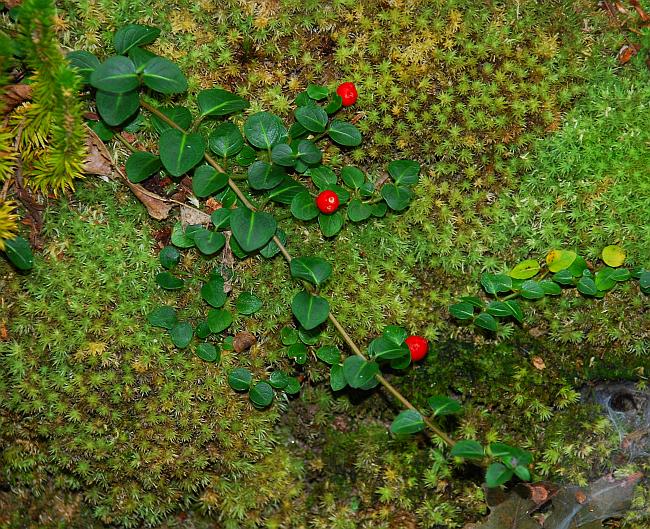Mitchella repens L.
Partridge Berry

Native
CC = 7
CW = 3
MOC = 12
© SRTurner
Mitchella repens L.Partridge Berry | |
 |
Native CC = 7 CW = 3 MOC = 12 |
© SRTurner |
|
Family - Rubiaceae Habit - Perennial forb. Stem - To 50 cm, prostrate, creeping (sometimes pendant from bluff ledges), usually rooting at the nodes, often forming mats, rounded or sometimes channeled on 2 opposing sides, minutely pubescent with short, straight to curved hairs or nearly glabrous.
Leaves - Opposite, petiolate, simple, stipulate, usually evergreen. Petioles 1-15 mm long, somewhat thickened, leathery, and succulent. Stipules interpetiolar, 0.5-1.0 mm long, triangular, generally persistent, pointed at the tip or sometimes lobed, often minutely gland-tipped. Leaf blades glabrous, 5-20 mm long, 5-20 mm wide, broadly ovate to nearly circular, rounded to broadly pointed at the tip, broadly rounded to slightly cordate at the base, the upper surface dark green, usually glossy, the undersurface green, the venation with the midvein and usually 2 or 3 pairs of pinnate, secondary veins visible.
Inflorescence - Terminal and occasionally also axillary, of usually 2 flowers at the tip of a common stalk 1-4 mm long.
Flowers - Flowers distylous, the hypanthia of each pair fused into a single unit. Calyces deeply lobed, the lobes 0.5-1.0 mm long, broadly triangular. Corollas funnelform, white, externally glabrous, the tube 7-10 mm long, densely bearded in the throat with the pubescence usually extending onto the lobes, the lobes usually 4, 3-4 mm long, ovate-triangular, spreading to slightly recurved, not overlapping in bud. Stamens usually 4, attached in the corolla throat, in short-styled flowers the anthers well exerted, in long-styled flowers the anthers situated in the throat and not or only partially visible from the outside of the corolla. Ovaries of each flower pair (or trio) fused, inferior, each 4-locular, the ovules 1 per locule. Style 1, slender, terminating in 4, short, linear stigmas, in short-styled flowers these positioned near the midpoint in the corolla tube, in long-styled flowers well-exserted.
Fruit - Fruits of the 2(3) flowers in each inflorescence fused into a single unit with a pair of minute, persistent calyces at the tip, berrylike drupes, 6-9 mm long, 7-10 mm wide, subglobose to depressed-globose, bright orange to red, with a total of 4-8(-12) small stones.
Flowering - May - July. Habitat - Bluff bases, bottomland forests, streambanks, usually on sandy or acidic substrate. Origin - Native to the U.S. Lookalikes - Broadly, and vegetatively, Euonymus fortunei. Other info. - This characteristic species of sandstone canyons and ledges is fairly common in Missouri only where this type of habitat exists, in a few counties in the southeastern portion of the state. Its broader distribution includes most of the eastern continental U.S. and parts of Canada, Mexico, and Central America. When flowering or fruiting it is more or less unmistakable. The peculiarly paired white flowers are unique, as are the fused, bright red fruits. Photographs taken at Pickle Springs Natural Area, Ste. Genevieve County, MO, 9-19-2009, and at Don Robinson State Park, Jefferson County, MO, 5-24-2017 (SRTurner). |